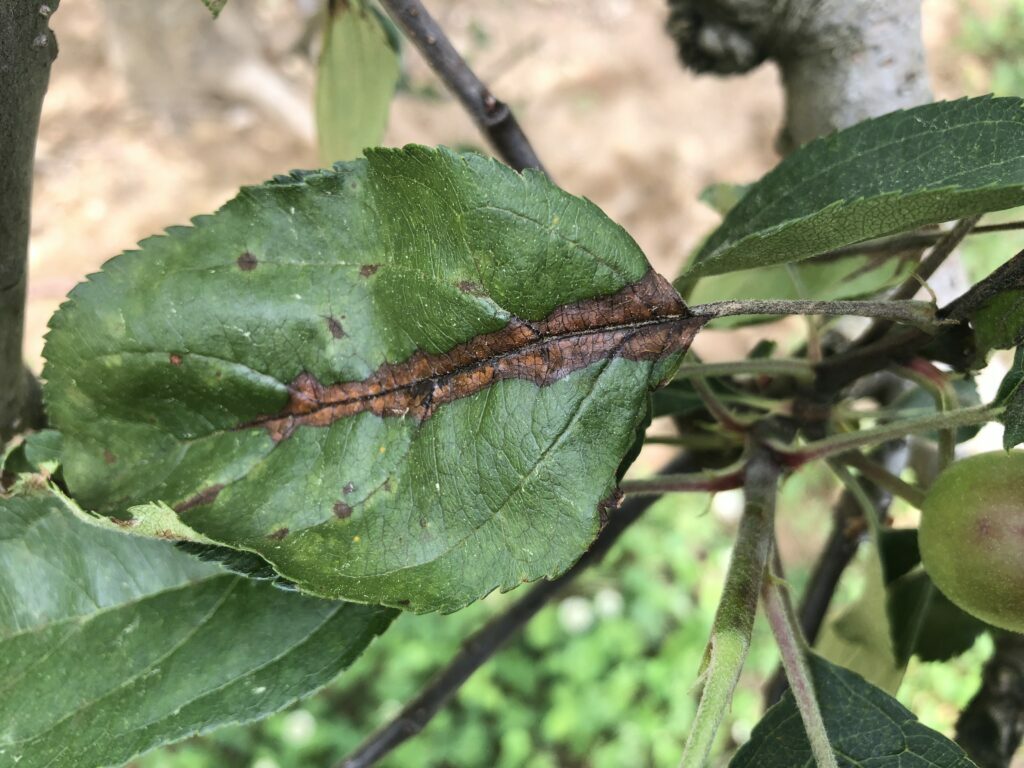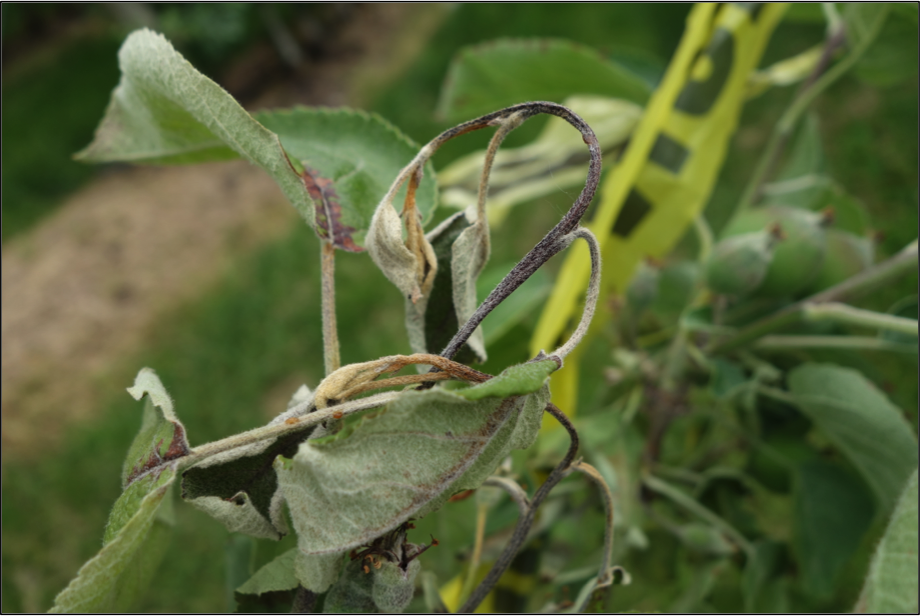Apple Disease Update: Week of May 18, 2025
go.ncsu.edu/readext?1073326
en Español / em Português
El inglés es el idioma de control de esta página. En la medida en que haya algún conflicto entre la traducción al inglés y la traducción, el inglés prevalece.
Al hacer clic en el enlace de traducción se activa un servicio de traducción gratuito para convertir la página al español. Al igual que con cualquier traducción por Internet, la conversión no es sensible al contexto y puede que no traduzca el texto en su significado original. NC State Extension no garantiza la exactitud del texto traducido. Por favor, tenga en cuenta que algunas aplicaciones y/o servicios pueden no funcionar como se espera cuando se traducen.
Português
Inglês é o idioma de controle desta página. Na medida que haja algum conflito entre o texto original em Inglês e a tradução, o Inglês prevalece.
Ao clicar no link de tradução, um serviço gratuito de tradução será ativado para converter a página para o Português. Como em qualquer tradução pela internet, a conversão não é sensivel ao contexto e pode não ocorrer a tradução para o significado orginal. O serviço de Extensão da Carolina do Norte (NC State Extension) não garante a exatidão do texto traduzido. Por favor, observe que algumas funções ou serviços podem não funcionar como esperado após a tradução.
English
English is the controlling language of this page. To the extent there is any conflict between the English text and the translation, English controls.
Clicking on the translation link activates a free translation service to convert the page to Spanish. As with any Internet translation, the conversion is not context-sensitive and may not translate the text to its original meaning. NC State Extension does not guarantee the accuracy of the translated text. Please note that some applications and/or services may not function as expected when translated.
Collapse ▲
 Severe weather has continued to challenge apple production in western NC this season, as more local hail events hit the region early Saturday morning. If you had damage to leaves or fruit, you may want to consider an application of the high rate of streptomycin no later than Monday morning (5/19/25) to limit shoot blight infections from this latest potential trauma blight event. If you need to apply strep, consider hitting blocks that may have active fire blight infection in them, and/or in highly susceptible cultivars like ‘Pink Lady’ or ‘Gala’.
Severe weather has continued to challenge apple production in western NC this season, as more local hail events hit the region early Saturday morning. If you had damage to leaves or fruit, you may want to consider an application of the high rate of streptomycin no later than Monday morning (5/19/25) to limit shoot blight infections from this latest potential trauma blight event. If you need to apply strep, consider hitting blocks that may have active fire blight infection in them, and/or in highly susceptible cultivars like ‘Pink Lady’ or ‘Gala’.
Speaking of shoot blight, did you know that NEWA has a tool for forecasting shoot blight symptoms following an infection event? Trauma blight can occur following events such as a windy thunderstorm or hail storm. In Wilkes, Polk, and Henderson Counties, shoot blight symptoms were predicted to begin to show up on the followings dates:
- Wilkes County: May 16, 2025
- Polk County: May 15, 2025
- Henderson County: Saturday May 17, 2025
If you start to see symptoms of shoot blight: Blackening of the midvein of leaves (see above photo), shepherd’s crook (see below photo) and wilting due to clogging of xylem vessels it’s important to promptly remove the infection. If symptoms are sporadic and few, cut at least 18 inches below the leading infection margin (the fire blight pathogen will travel down the shoot towards the central leader or older wood). You may want to make spot applications with streptomycin (PPE/label rules still apply) following removal of the blighted shoots and do not prune first thing in the morning or on day when rain is predicted. Also, a recent multi-state study on shoot blight removal found that tearing out blight branches worsens shoot blight symptoms and its spread. If you shoot blight widespread throughout a block, consider an application of Kudos (12 oz/100 gal) first, and then follow up with pruning.
In regards to fungicides this week, this is the time that you’ll likely be switching from mancozeb to captan for cover sprays. However, if you have not applied 21 lbs yet of Manzate Pro-Stick, Roper, Koverall, or a similar mancozeb product, AND you are not within 77 days of harvest, you may want to consider maxing out your seasonal application limit to avoid burning through your captan annual limits too quickly. Also, with the lack of availability of Ziram, rationing captan is of utmost importance this year.
Some fungicide options to consider:
- Young, non-bearing trees: Since fruit rot will not be a concern, I’d consider fungicide applications every 10 days or so on GLS susceptible cultivars and every 14-21 days (depending on weather) for cultivars that are not susceptible to GLS. Powdery mildew tends to be a bigger concern in young trees as you don’t want to lose any photosynthetic activity of these trees and there is often susceptible leaf tissue on young cultivars throughout much of the summer months. Captan (or mancozeb if not harvesting) is a great choice for most diseases on young trees with the exception of powdery mildew. I’d urge applying an older DMI (or even sulfur if not too hot) or a FRAC 7 for mildew control every other fungicide application, particularly on cultivars prone to mildew infection such as ‘Honeycrisp’.
- It is around this time, that two applications of a FRAC 11 fungicide, such as Merivon, should be applied on GLS susceptible cultivars. The goal being to target early infections and knock down Colletotrichum inoculum. Remember to include 2.5 lb/A of Captan 80 WDG (or Manzate 3 lb/A) with any single-site/locally systemic fungicide.
- If you’ve already applied two applications of Merivon (or a similar FRAC 11 fungicide) or have/suspect resistance to strobilurins (FRAC 11s) captan or mancozeb applied alone should be adequate this week, particularly if you’re applying on 7 to 10 day intervals.
- If Marssonina leaf blotch is a major concern, Tesaris (fluxapyroxad, FRAC 7), Cevya (FRAC 3), and Inspire Super (FRAC 3 + 9) have performed well in our trials at the MHCREC. While Tesaris is an excellent option, keep in mind that it contains one of the two active ingredients in Merivon. Be careful not to go over the annual limits for this active.
Next week, I’ll have a more in depth post on fungicide resistance. I’ll be away for Memorial Day weekend, but promise to have a post in your inbox by Tuesday.



